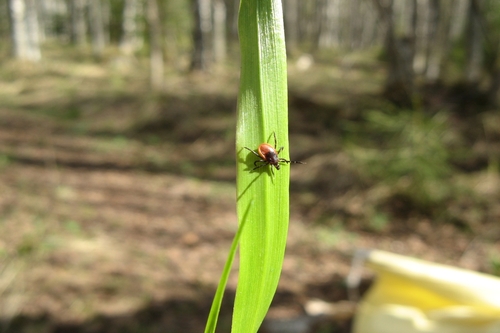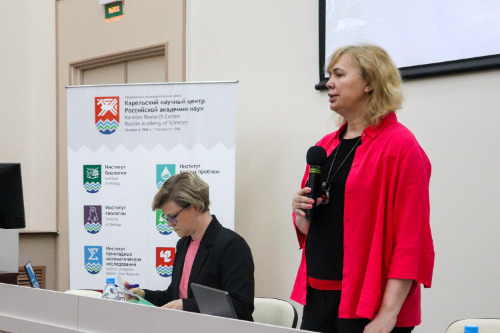Scientists from the Karelian Research Center RAS have described the seasonal activity of taiga ticks over the 30-year period of observations at the parasitological research station in Gomselga (Kondopoga District, Karelia). In the republic, tick abundances can vary considerably between years. At the same time, the taiga tick was found to have become more abundant in the north of its range, and the onset of its activity shifted to earlier dates. The results were published in the Animals Journal. The research was supported by a RSF grant and the Republic of Karelia Venture Capital Fund: https://rscf.ru/project/23-14-20020/
— During the activity season, rises and declines in taiga tick numbers often alternate. The reason for such fluctuation is the changeable weather in spring and early summer, when periods with favorable temperatures are suddenly interrupted by cold spells or frosts, which temporarily suppress the activity of ticks. This can be vividly illustrated by comparing two successive years. In 2016, the seasonal activity of taiga ticks was typical for Karelia. The first ticks were detected in the last third of April. A sharp warming in the second half of April triggered rapid snow melting and warming of the forest floor to an optimal temperature, as well as a rise in the species' abundance. It peaked in early May. In 2017, air temperatures in April and May were low and snow melted late. The entire course of the ticks' seasonal activity was significantly altered. It peaked in mid-June, and encounters continued all through July, — told Sergey Bugmrin, Head of the Laboratory of Animal and Plant Parasitology at the Institute of Biology KarRC RAS.
The intensity of snow melt and soil warming, which determines the onset of tick activity, depends not only on the year of study, but also on the habitat characteristics. The active season in taiga ticks of Karelia begins when mean daily air temperatures reach +3 to +8 °C and the forest floor temperature is 0 to +3 °C. During the peak activity period, mean daily air temperatures are +5 to +15 °C, the forest floor temperature is +4 to +11 °C. In open sites (clear-cuttings, fields, household plots), snow melts much earlier than in forest habitats.
— We detected a tendency for an earlier onset of tick activity in recent decades. It is consistent with the results of long-term phenological observations conducted in the Kivach Nature Reserve, located 20 km north of our study area. The timing of emergence of the first ticks is determined by the beginning of snowmelt, which is shifting to earlier dates. This is largely related to the general climate trend, — the researcher explained.

Seasonal (every 10 days) changes in taiga tick numbers in the long-term monitoring area (Gomselga, Kondopoga District) during two periods of observations. Plot from an article by S. Bugmyrin and L.Bespyatova https://www.mdpi.com/2076-2615/13/24/3834. ("4" is the April dataset, "5"- May, "6"- June, "7" - July)
In our region, the taiga tick activity subsides by mid-summer. As a rule, the later records are encounters of another species — the castor bean tick, Ixodes ricinus. It mostly occurs in south-western Karelia, being scant in other parts of the republic.
— The biology of the castor bean tick is different. Females of this species can overwinter in blood-satiated condition.That is why they are active in autumn. This species has a flatter activity curve: they emerge in May, their abundance grows gradually towards mid-summer, and these ticks can be encountered until September. However, their numbers are much lower than those of the taiga tick, which accounts for up to 95% of attacks, — the scientist explained.
This year, due to the snowy winter and cold April, ticks have not been very active so far. According to the Federal Service for Supervision of Consumer Rights Protection and Human Welfare, the first case of tick attack was registered in mid-April in the Olonets District. During the week from April 15 to April 21 only three attacked persons called at the republic's medical organizations.
- Ticks are slow to wake up due to the later onset of spring, but if May turns out warm, the numbers of these arachnids will rise rapidly, - summarized Sergei Bugmyrin.








